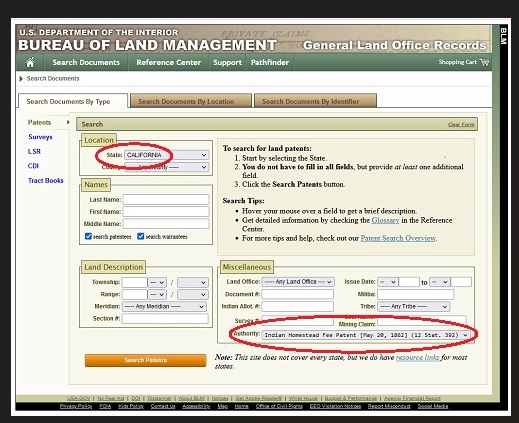Native people were able to acquire land from the public domain beginning in 1875 via the Indian Homestead Act. Those who abandoned tribal relations and were at least 21 years old could acquire a homestead on the public domain under the general land laws. An 1884 law eliminated the tribal severance requirement and extended the federal trust period from five to twenty-five years. These laws preceded the well-known General Allotment (Dawes) Act of 1887.
Kelsey considered the 1875 and 1884 laws “of little value.” Not until 1891 were allotting agents assigned to California. As Kelsey saw it, this meant that in California’s first forty years of statehood, its native people had “no practical way…to acquire title to land from the public domain” (“Mr. Kelsey’s Brief History of the California Indians” in Warren K. Moorehead, The American Indian in the United States, 333).
A quick search of the BLM General Land Office Records database (see header image) confirms the low use of the Indian Homestead Act in California. Searching the state for the two Indian homestead options–“Indian Homestead Fee Patent” and “Indian Homestead Trust”–in the authority picklist yields only a couple of pages of results, whereas the “Indian Allotment – General” option yields more than one hundred pages.
The laws about acquiring public land are confusing, but as Kelsey recognized, they are essential to understanding how nearly all of California was taken from native people. Here’s my attempt to make sense of Indian homesteads and allotments on the public domain in California.
The Homestead Act of May 20, 1862 (12 Stat. 392) allowed settlers to apply for up to 160 acres of public land if they lived on it for five years and provided proof of cultivation. The land was free but there was a filing fee. A citizenship requirement excluded native people.
The Indian Homestead Act of March 3, 1875 (18 Stat. 420) extended the benefits of the Homestead Act to native people. The native homesteader followed the same procedures as a non-Indian homesteader, but title was placed in federal trust for five years. Indian homesteaders had to relinquish their tribal ties but could retain their share of tribal funds.
The amended Indian Homestead Act of July 4, 1884 (23 Stat. 96) eliminated the tribal severance requirement and filing fees. It also extended the federal trust period from five to twenty-five years.
Especially before 1887, the Indian Homestead Acts of 1875 and 1884 were used by nonreservation peoples around the country to remain on or near their homelands and maintain their culture beyond the reach of government officials. They included the Winnebagos (article by Nancy O. Lurie), Wisconsin Ho-Chunk (Angela Firkus), Northern Cheyenne (James R. Allison III), Spokane Indians/Deep Creek colony (John W. W. Mann), and Columbia River Indians (Andrew H. Fisher).
The General Allotment (Dawes) Act of February 8, 1887 (24 Stat. 388) made allotments to Indians from the public domain subject to the provisions governing allotments on Indian reservations. Section 4 of the act dealt with public domain allotments. Applicants had to register intent with a federal Indian agent and prove actual residence on the land but did not require proof of improvement. The land was held in trust for twenty-five years, though the length of the trust period changed with amendments.
Both the Indian Homestead Act and Section 4 of the Dawes Act allowed native people to acquire land on the public domain, and both were available over multiple decades beginning in 1887. Because the two laws had small differences, a well-informed applicant could choose the more favorable one. For example, after the Interior Department issued new regulations in 1918, allottees were limited to forty acres of irrigable land under the General Allotment Act. Historian Martha C. Knack described how Tim Hooper (Shoshone) wanted to file an allotment for 160 acres of irrigable land in Nevada, but the General Land Office directed him to file under the Indian Homestead Act instead because that act did not distinguish land qualities, thus allowing Hooper to file for the full 160 acres.
